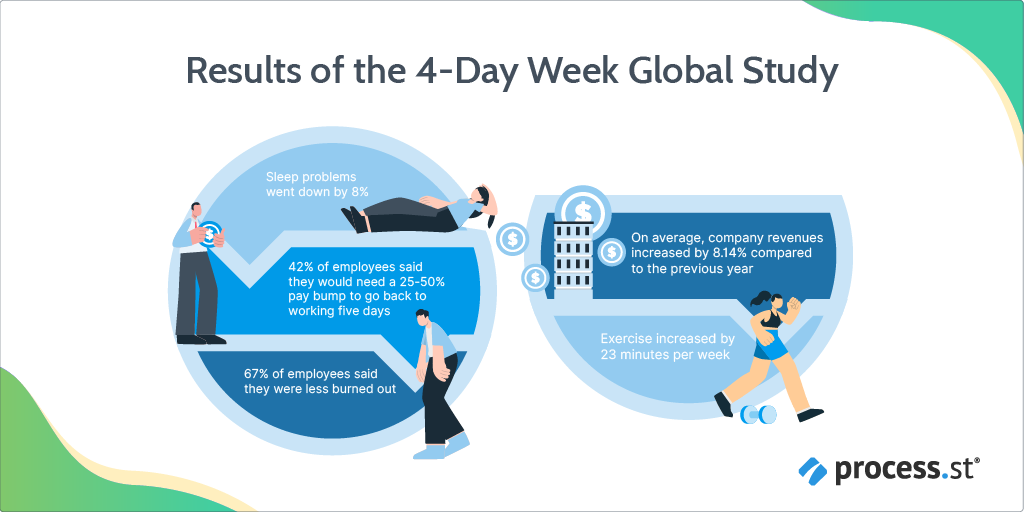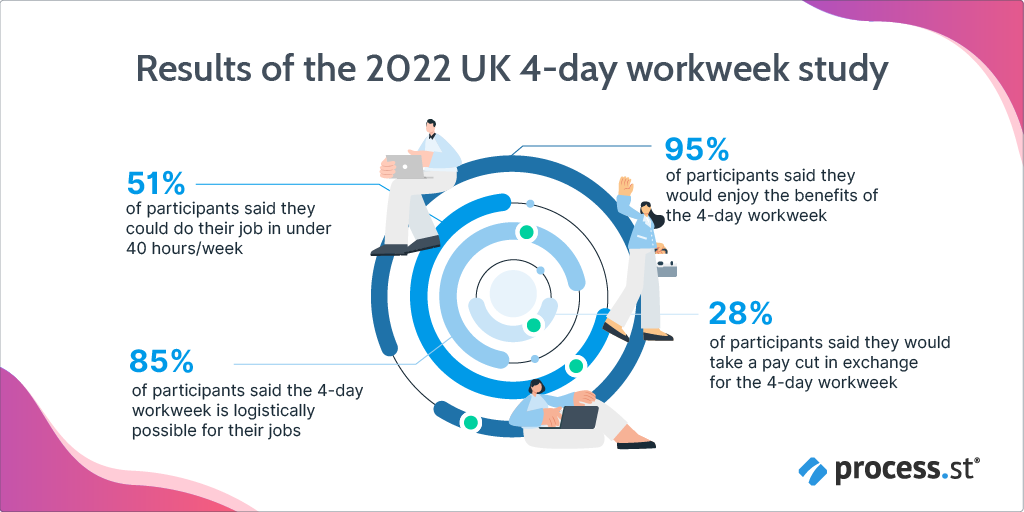
Every few months, the idea of the four-day workweek starts trending. And it’s not just making the rounds on TikTok, Twitter, and Reddit. Big publications like Forbes and Time also frequently cover the topic.
As more and more countries introduce bills advocating for the 4-day workweek and as more and more studies show the benefits of it, the clearer it becomes that this is not going anywhere anytime soon.
But why is that? Is the four-day workweek as good as people are saying? Is it something companies need to start adopting?
In this post, we will discuss:
- What is the four-day workweek?
- Where did the four-day workweek come from?
- Pros of the four-day workweek
- Cons of the four-day workweek
- Why you’re going to keep hearing about the four-day workweek
What is the four-day workweek?

The answer is in the name, really. The four-day workweek is a workweek that is four days instead of five.
Most companies that adopt it opt for their employees to have a weekend from Friday to Sunday, but others go for Saturday to Monday. It doesn’t really matter what that third day is, the point is to make the weekend one day longer every week.
The idea is to give employees more time to themselves to do things like:
- Rest
- Spend time with friends and family
- Work on their hobbies
- Go to appointments
- Run errands
To many, it’s a radical idea. I mean, two days a week to do all that stuff is plenty, right? Well, as times change, people are beginning to argue that it simply isn’t.
Where did the four-day workweek come from?
Establishing the five-day workweek
You know, there was once a time when the five-day workweek was considered to be a crazy idea. During the Industrial Revolution, people were forced to work 10-12 hour days, six days a week.
It wasn’t until Henry Ford fully adopted the 40-hour, five-day workweek in his factories in 1926 that changes started to be made. It was a massive upset in the labor world, which was still lacking a lot of important safety regulations.
Of the policy, Ford’s son Edsal, the president of the company, said:
“Every man needs more than one day a week for rest and recreation….The Ford Company always has sought to promote [an] ideal home life for its employees. We believe that in order to live properly every man should have more time to spend with his family.”
However, it wasn’t until 1940 that Congress amended the Fair Labor Standards Act to limit the workweek to 40 hours.
Let that sink in for a minute. The 40-hour workweek has only been around by law since 1940. It has barely been the standard for one generation of people.
A shorter workweek is not a new idea
Though the 40-hour week has only been with us since 1940, it feels like it’s been with us forever. It’s ingrained in our entire work culture. But even in countries that don’t abide by the 40 hours, like the many in Europe who work 35, the five-day workweek is the standard.
This mass advocacy for the four-day workweek may seem new, modern, and radical, but the truth is that the idea for a shorter workweek is far from it.
Back in 1928, the economist John Maynard Keynes predicted that within a century, people would be working 15 hours per week. Then in 1965, a subcommittee of the US Senate predicted that by 2000, the workweek would be 14 hours long, and people would be guaranteed seven weeks of vacation.
And for any non-Americans reading this, most people in the US get two weeks of vacation per year, so the idea of seven weeks off is insane.
Unfortunately, due to several major events that rocked the United States, including
- The Great Depression
- World War II
- Bone-chilling fear around Communism (to some, less work = more Communism)
- Women entering the workforce (focusing on equality over working hours)
People began focusing on cutting work hours less and less. And as a result, nothing has yet to change. But it will soon.
Why it keeps coming back
As we entered the 21st century and tech companies began taking over the world, we began to see greater disruption in the status quo of work. They began to rethink the traditional 9-to-5 and since 2018 we have seen study after study of the four-day workweek yield some incredible results.
In 2018, a company out of New Zealand called Perpetual Guardian gave the four-day workweek a trial run and was so happy with the outcome that they made it permanent.
In 2019, Microsoft tested it out with its subsidiary in Japan, resulting in a 40% increase in productivity.
And then 2020 happened. Our working culture has never been disrupted like that before. The pandemic forced us all to reassess the most important things in our lives, including how we work.
For the first time, a lot of people were working fewer hours, working remotely, or perhaps not working at all. For some, it was a positive experience, for others it was very negative. But no matter which side of the line people fell on, people came to the same conclusion: The way we work needs to change.
We all learned the incredible importance of work-life balance. We learned how having more time to actually live and spending time with the people you care about improves the quality of your life immensely.
So when people began returning to the office in 2021, they brought with them their demands for improved working hours. Company resistance to these demands was a massive contributor to the Great Resignation.
But the reset that COVID gave us is the reason that now, years after the pandemic, the idea of the four-day workweek isn’t going anywhere.
Pros of the four-day workweek

Despite what some Boomers and political pundits may say, the four-day workweek doesn’t just exist for people who don’t want to work. It actually has some incredible benefits for businesses as well as employees, as backed by numerous studies.
Let’s break them down.
Lower business expenses
For those businesses that still have offices, energy savings can be massive. With Microsoft’s experiment in Japan, just having their offices closed one extra day out of the week saved them 20% in energy costs.
They also saw a 60% reduction in the amount of printed paper they used, saving even more money as well as reducing their carbon footprint.
Expenses are lowered for employees as well, who save on transportation costs by removing a day out of the week they need to be at the office.
Better productivity
For most businesses, the four-day workweek doesn’t reduce productivity, it either stays the same or increases, even if employees work fewer hours. But don’t just take my word for it. The studies speak for themselves.
The majority of the 61 companies that participated in the 2022 UK four-day workweek study found that they either maintained or increased their overall productivity. 33 of the companies even saw an increase in overall revenue.
A separate company from England that was not part of the study, Since Search Intelligence Ltd, did a trial of their own in 2022 and found that their productivity went up 25-30%. They were so happy with the results that they adopted the model permanently.
And it’s not just companies in the UK finding success in the four-day workweek. There have been studies conducted in Belgium, Spain, Australia, Japan, and New Zealand that have yielded similar results.
There’s something really important to note here. All of the companies mentioned, particularly in the UK trial, worked with reduced hours. They did not condense the 40-hour workweek into four 10-hour days. They reduced the working hours for their employees across the board. And even with doing that, they still maintained the same level of productivity.
Happier, more relaxed employees
Okay, it’s definitely not all about businesses. Employees see huge benefits, too. Looking back at the UK study, it’s clear that the vast majority of them much preferred the four-day week.
As part of the parameters of the study, employees received their full pay and benefits, so many saw the reduction in hours the same as a 25% pay bump. In fact, 42% of the participants said they would require a pay increase of 25-50% if they were asked to return to working 5 days.
Some participants even said that they wouldn’t return to the five-day week for any amount of pay. The extra day they had for their personal lives every week was more valuable than money.
Outside of work, employees were able to find more time for exercise and sleep problems went down by 8%.
Additionally, employees became happier in their work. 67% of the participants reported less burnout and did not notice any significant increase in their workload. That made them feel happier when they were at work, which meant they did better work.
Cons of the four-day workweek

Of course, not everything is sunshine and rainbows. There are criticisms of the four-day workweek and some of them are valid.
Doesn’t work for every business
Not every sector of business can be closed for any length of time. Think healthcare and emergency services. They won’t save any money by adopting a four-day workweek. Actually, they may even see costs increase.
If the federal government set the maximum number of hours worked at 32 instead of 40, many hospitals and healthcare facilities would find themselves having to pay more for overtime as their employees tend to work longer hours.
Scheduling issues
Even if industries such as healthcare adopted the four-day workweek for their employees, it wouldn’t look the same for everyone. Some might have every other day off, some may have Friday, Saturday, and Wednesday off.
It likely wouldn’t be that they would all have three consecutive days off, which could mean they wouldn’t receive the same mental benefits as other workers.
Even in more traditional environments, cutting out a day that everyone is working can mean that it’s difficult to set meetings or respond to customer concerns. This isn’t the end of the world, though. It would just take some finessing and time to get used to it. But it’s certainly a concern worth considering.
Less collaboration
For creative and tech industries where collaboration is essential, the four-day workweek can present a problem by cutting out time for it.
This can lead to less overall creativity in a company if you’re not careful. Companies that rely on collaboration need to take special care to schedule time for it during the shortened workweek.
Why you’re going to keep hearing about the four-day workweek
The four-day workweek isn’t going anywhere. You’re going to keep hearing about it. With study after study from all parts of the world showing overwhelming success, it’s just inevitable.
Employees are going to start demanding it more, and companies who offer it will have a competitive advantage over the ones who don’t. Not only will they attract top talent, but they will have far better retention. Not to mention the possibility of increased profits.
It’s not unlikely that within a few years, those companies that don’t offer four-day workweeks will be considered old-fashioned, out of touch, and perhaps even a little exploitative.
COVID gave workers a taste of what a better work-life balance is like and they are not going to give up on it. They understand their power and they are the ones who will change the culture.
Has your company considered giving the four-day workweek a try? Tell us about why you decided to or not to in the comments below!







 Workflows
Workflows Projects
Projects Data Sets
Data Sets Forms
Forms Pages
Pages Automations
Automations Analytics
Analytics Apps
Apps Integrations
Integrations
 Property management
Property management
 Human resources
Human resources
 Customer management
Customer management
 Information technology
Information technology



Isabella Busby-Priest
Isabella Busby-Priest is a content writer with a keen interest in all things environment, nature, travel, and culture. When she's not creating new blog content, you'll often find her reading in odd places or planning a trip to a new country.